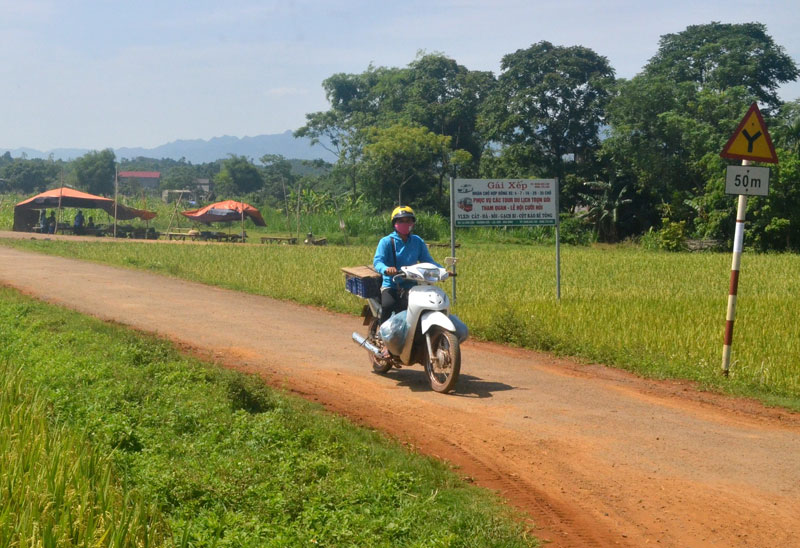
HBO – The road linking Thien village in Van Son commune and Than village in Mien Doi commune – the two extremely disadvantaged communes of Hoa Binh province’s Lac Son district, has the length of over 5 kilometres. On rainy or hot days, it takes from five to 10 minutes going through this short and beautiful road by motorcycle or a little longer by bicycle for locals who are familiar with transporting agricultural products to the district market. Seeing the road at present, many people will be surprised if they know that this road used to push a lot of locals into a miserable situation several years ago.

Van Son-Mien Doi road proves
effective, contributing to socio-economic development in beneficiary communes.
Some years ago, the provincial People’s Committee approved a Van
Son-Mien Doi
road project with a total investment of 34.2 billion VND, in which
28 billion VND came from the Japan International Cooperation Agency (JICA)’s
credit programme and 6.2 billion VND from the provincial budget. The road was
designed to have the length of over 5km and width of 5m, and covered with
three-layer asphalt, along with the roadsides, and the wastewater drainage and
traffic safety systems. Construction on the road started in 2013, and the road
was open to traffic in late June of 2016, meeting locals’ expectation of an
easy road connecting Mien Doi and Van Son communes with the district centre as
well as linking with the district’s transport system. This is a significant
"gift” to disadvantageous localities like Van Son and Mien Doi communes.
Bui Van Quyet, police chief of Van Son commune, said that, since
it was put into use, the road has contributed to changing the life of local
people. The distance between the two communes and the district centre is
shortened, and rural infrastructure is improved, thus facilitating the travel
of students and locals’ health check-ups and treatment. Notably, the new road
has also made agricultural products be sold easily, without money squeeze,
which makes locals happier and more resolved in investing in agricultural
production so as to boost poverty reduction and economic development./.
The Department of Education and Training of Hoa Binh province held a conference on March 18 to review the performance of the "Safe and Happy School" Project and set out tasks for 2025. The project, funded by the Taiwan Fund for Children and Families (TFCF), aims to create a safe, inclusive, and supportive learning environment for students. The event saw the attendance of representatives from the TFCF and 26 beneficiary schools.
With over 70% of their workers being women, trade unions across industrial parks (IPs) in Hoa Binh have been actively safeguarding their legal rights and interests while implementing initiatives to improve their income and well-being.
In recent years, the Hoa Binh provincial General Hospital has continuously innovated itself and improved the quality of medical services to meet the increasing needs of local people. With substantial investments in infrastructure and modern equipment, along with a team of highly qualified doctors and nurses, the hospital has gradually established itself as one of the leading medical units in the Northwestern region and a trusted destination for healthcare for people inside and outside the province.
From mastering the fundamentals of programming to achieving national recognition, the Programming Club of the Le Van Tam Primary School (STAR LVT28) in Hoa Binh city has made remarkable strides in the field of robotics.
The Ho Chi Minh Communist Youth Union Committee and the Vietnam Youth Federation chapter of Hoa Binh province organised a programme on March 12 to launch the "Digital Literacy" movement and an online quiz on the resolutions of the Vietnam Youth Federation congresses at all levels, as well as the Politburo's Resolution No. 57-NQ/TW on breakthroughs in the development of science, technology, innovation, and national digital transformation.
As climate change grows more unpredictable, the development of production forests has become essential - not just for economic growth, but for safeguarding the environment and maintaining ecosystem balance. By boosting local incomes, curbing natural disasters, preventing soil erosion, and protecting water resources, these forests play a crucial role in sustainable development.



